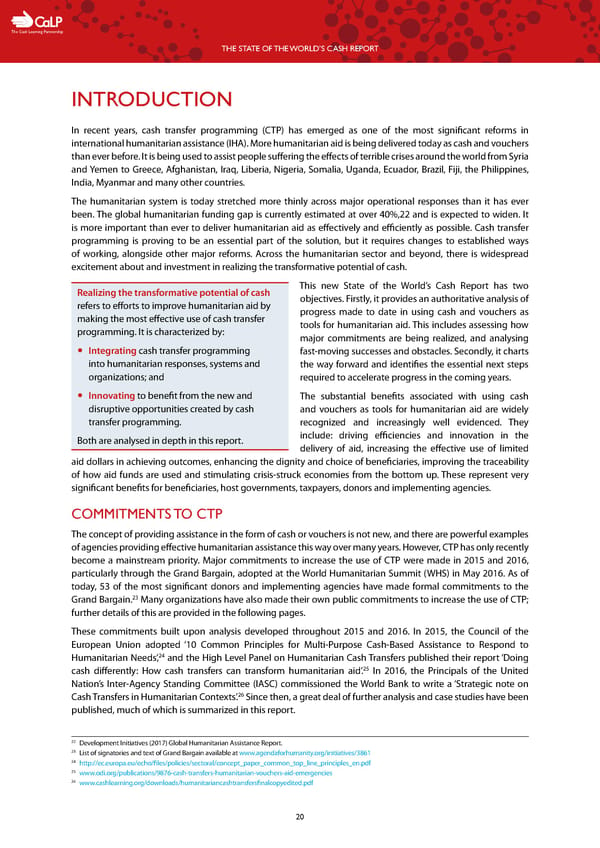C The Cash Learning Partnership THE STATE OF THE WORLD’S CASH REPORT INTRODUCTION In recent years, cash transfer programming (CTP) has emerged as one of the most significant reforms in international humanitarian assistance (IHA). More humanitarian aid is being delivered today as cash and vouchers than ever before. It is being used to assist people suffering the effects of terrible crises around the world from Syria and Yemen to Greece, Afghanistan, Iraq, Liberia, Nigeria, Somalia, Uganda, Ecuador, Brazil, Fiji, the Philippines, India, Myanmar and many other countries. The humanitarian system is today stretched more thinly across major operational responses than it has ever been. The global humanitarian funding gap is currently estimated at over 40%,22 and is expected to widen. It is more important than ever to deliver humanitarian aid as effectively and efficiently as possible. Cash transfer programming is proving to be an essential part of the solution, but it requires changes to established ways of working, alongside other major reforms. Across the humanitarian sector and beyond, there is widespread excitement about and investment in realizing the transformative potential of cash. Realizing the transformative potential of cash This new State of the World’s Cash Report has two refers to efforts to improve humanitarian aid by objectives. Firstly, it provides an authoritative analysis of making the most effective use of cash transfer progress made to date in using cash and vouchers as programming. It is characterized by: tools for humanitarian aid. This includes assessing how major commitments are being realized, and analysing — Integrating cash transfer programming fast-moving successes and obstacles. Secondly, it charts into humanitarian responses, systems and the way forward and identifies the essential next steps organizations; and required to accelerate progress in the coming years. — Innovating to benefit from the new and The substantial benefits associated with using cash disruptive opportunities created by cash and vouchers as tools for humanitarian aid are widely transfer programming. recognized and increasingly well evidenced. They Both are analysed in depth in this report. include: driving efficiencies and innovation in the delivery of aid, increasing the effective use of limited aid dollars in achieving outcomes, enhancing the dignity and choice of beneficiaries, improving the traceability of how aid funds are used and stimulating crisis-struck economies from the bottom up. These represent very significant benefits for beneficiaries, host governments, taxpayers, donors and implementing agencies. COMMITMENTS TO CTP The concept of providing assistance in the form of cash or vouchers is not new, and there are powerful examples of agencies providing effective humanitarian assistance this way over many years. However, CTP has only recently become a mainstream priority. Major commitments to increase the use of CTP were made in 2015 and 2016, particularly through the Grand Bargain, adopted at the World Humanitarian Summit (WHS) in May 2016. As of today, 53 of the most significant donors and implementing agencies have made formal commitments to the Grand Bargain.23 Many organizations have also made their own public commitments to increase the use of CTP; further details of this are provided in the following pages. These commitments built upon analysis developed throughout 2015 and 2016. In 2015, the Council of the European Union adopted ‘10 Common Principles for Multi-Purpose Cash-Based Assistance to Respond to Humanitarian Needs’,24 and the High Level Panel on Humanitarian Cash Transfers published their report ‘Doing 25 cash differently: How cash transfers can transform humanitarian aid’. In 2016, the Principals of the United Nation’s Inter-Agency Standing Committee (IASC) commissioned the World Bank to write a ‘Strategic note on 26 Cash Transfers in Humanitarian Contexts’. Since then, a great deal of further analysis and case studies have been published, much of which is summarized in this report. 22 Development Initiatives (2017) Global Humanitarian Assistance Report. 23 List of signatories and text of Grand Bargain available at www.agendaforhumanity.org/initiatives/3861 24 http://ec.europa.eu/echo/files/policies/sectoral/concept_paper_common_top_line_principles_en.pdf 25 www.odi.org/publications/9876-cash-transfers-humanitarian-vouchers-aid-emergencies 26 www.cashlearning.org/downloads/humanitariancashtransfersfinalcopyedited.pdf 20
 The State of the World's Cash | Full Report Page 21 Page 23
The State of the World's Cash | Full Report Page 21 Page 23